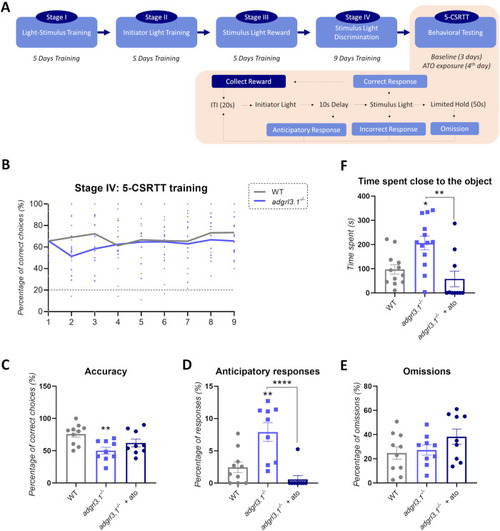|
adgrl3.1−/− shows attention deficits, impulsivity, and increased risk-taking. A Flow-chart summarizing the 5-CSRTT process. During the 5-CSRTT, fish were required to swim toward one of five spatially distinct LEDs when illuminated. Approaches to the illuminated light were ‘correct’ and the proportion of correct trials was a measure of attention. Prior to illumination, there was a variable-time (mean 5-s) inter-trial interval, and responses during this interval were punished with subsequent non-reinforcement. Responses during this inter-trial interval (anticipatory or premature responses) were used as a measure of impulse control. B No significant effects were found after two-way RM ANOVA for the acquisition during the Stage IV of the 5-CSRTT (Day*Group effect—F(8, 136) = 0.50; p = 0.95; Group effect—F(1, 17) = 0.69; p = 0.41; Day effect—F(4, 247) = 0.45; p = 0.77). C One-way ANOVA yielded a significant effect for accuracy (F(2,25) = 5.80; p** = 0.0085), D anticipatory responses (F(2,25) = 14.17; p**** < 0.0001) with no effects for (E) omissions (F(2,25) = 1.80; p = 0.18). Tukey’s post-hoc analysis was used to characterize significant differences (p** < 0.005 and p**** < 0.0001; n = 9–10). F Risk-taking behavior is defined as time spent close to the novel object. A significant ANOVA effect was observed for time spent close to the object (F(2,32) = 8.35; p** = 0.0012) where adgrl3.1−/− spent more time close to the object (p* = 0.0148), an effect that was 750 significantly decreased by atomoxetine in adgrl3.1−/− (p** = 0.015; n = 12–13). The data is represented as mean ± S.E.M.
|

